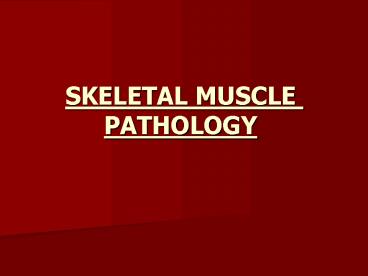SKELETAL MUSCLE PATHOLOGY - PowerPoint PPT Presentation
1 / 40
Title:
SKELETAL MUSCLE PATHOLOGY
Description:
SKELETAL MUSCLE PATHOLOGY Inclusion body myositis IBM causes progressive weakness of the muscles of the wrists and fingers, the muscles of the front of the thigh and ... – PowerPoint PPT presentation
Number of Views:408
Avg rating:3.0/5.0
Title: SKELETAL MUSCLE PATHOLOGY
1
SKELETAL MUSCLE PATHOLOGY
2
Normal skeletal muscle
3
Pathophysiological changes of muscles
- Atrophy and hypertrophy of muscles
4
Atrophy and hypertrophy of muscles
5
Muscle atrophies
- Muscle atrophy is defined as a decrease in the
mass of the muscle - Physiologically Muscle mass, muscle strength,
and bone density decrease in the elderly - Disuse atrophy of muscles can occur after
prolonged immobility such as extended bed-rest,
or having a body part in a cast. - This type of atrophy can usually be reversed with
exercise.
6
Disuse Atrophy Of Muscles
7
- There are many diseases and conditions which
cause atrophy of muscle mass. - For example diseases such as cancer and AIDS
induce a body wasting syndrome called "cachexia - Other conditions which can induce skeletal muscle
atrophy are congestive heart failure and liver
disease.
8
Severe generalized muscle atrophy Body wasting
syndrome called "Cachexia
9
Muscle hypertrophy
- Muscle hypertrophy is an increase in the size of
a muscle - Hypertrophy is an increase in mass of a muscle
that can be induced by a number of stimuli. The
most familiar of these is exercise. - Pathologically in Acromegaly disease there is
pathological muscle hypertrophy affecting mainly
the type (1) skeletal fibers
10
Exercise Muscle Hypertrophy
Acromegaly Disease
11
Muscle Diseases
12
Classification of Muscle Disease
- Inflammatory Myopathies
- Infectious Myositis
- Non-Infectious Myositis (Auto-immune )
- 1-Polymyositis
- 2-Dermatomyositis
- 3-Inclusion body myositis
- Diseases of the Neuromuscular Junction
- -Myasthenia Gravis
- -Lambert-Eaton Syndrome
13
- Dystrophies
- Duchennes Muscular Dystrophy
- Beckers Muscular Dystrophy
- Myotonic Dystrophy
- Metabolic Myopathies
- -Glycogen Storage Diseases
- -Mitochondrial Myopathies
- Toxic Myopathies
14
Inflammatory Myopathies
15
Inflammatory myositis
- Polymyositis
- Dermatomyositis
- Inclusion body myositis
- Are of auto-immune origin
16
Polymyositis (PM)
- It means "inflammation of many muscles") it is a
type of chronic inflammation of the muscles
possibly due to autoimmune causes
17
- Clinical presentation
- Adults
- Bilateral proximal muscle weakness
- Microscopic
- Endomysial lymphocytic inflammation
- Skeletal muscle fiber degeneration and
regeneration
18
POLYMYOSITIS mostly affects the muscles of the
hips and thighs, the upper arms, the top part of
the back, the shoulder area and the neck
19
Signs and symptoms
- Symptoms include pain with marked weakness and
loss of muscle mass in the proximal musculature
particularly in the shoulder and pelvic girdle. - The hip extensors are often severely affected
leading to particular difficulty in ascending
stairs and rising from a seated position. - Dysphagia (difficulty in swallowing) occurs in
1/3 of patients. - Low grade fever and peripheral lymphadenopathy
may be present.
20
Muscle weakness can cause difficulty in many
daily activities
21
Diagnosis
- History and physical examination
- Elevation of creatine kinase
- Electromyograph (EMG) alteration
- Positive muscle biopsy
22
(No Transcript)
23
Endomysial lymphocytic inflammation
Polymyositis
24
Dermatomyositis
- Dermatomyositis (DM) is a connective-tissue
disease related to polymyositis (PM) that is
characterized by inflammation of the muscles and
the skin. - The disease may also affect the joints, the
esophagus, the lungs, and, less commonly, the
heart.
25
Dermatomyositis
- Clinical presentation
- Children and adults
- Bilateral proximal muscle weakness
- Skin rashes (upper eyelids)
- Peri-orbital edema
- Microscopic
- Perimysial and vascular lymphocytic inflammation
- Skeletal muscle fiber degeneration and
regeneration
26
- Grotton lesions scaly erythematous eruptions or
red patches overlying the knuckles, elbows, and
knees - X-ray findings sometimes include dystrophic
calcifications in the muscles, and patients may
or may not notice small calcium deposits under
the skin
27
Gottron's papules Discrete erythematous papules
overlying the metacarpal and interphalangeal
joints in a patient with juvenile dermatomyositis
28
Gottron's sign. Confluent macular erythema with
scale confined to the skin overlying the patellae
in a juvenile dermatomyositis
29
X-Ray of the knee in a patient with
dermatomyositis
30
Clinical presentation
- The main symptoms include skin rash and symmetric
muscle weakness which may be accompanied by pain. - The heliotrope or "lilac" rash is a violaceous
eruption on the upper eyelids and in rare cases
on the lower eyelids as well, often with itching
and swelling
31
Eruption is associated with peri-orbital edema
and telangiectasias of the both eyelids.
32
Diagnosis
- The diagnosis of dermatomyositis is usually
confirmed by muscle biopsy, EMG and blood tests. - Liver enzymes, specifically creatin phosphokinase
(CPK), are the major tool in assessing the
progress of the disease and/or the efficacy of
treatment
33
Perimysial and vascular lymphocytic inflammation
Dermatomyositis
34
(No Transcript)
35
Inclusion body myositis
- IBM causes progressive weakness of the muscles of
the wrists and fingers, the muscles of the front
of the thigh and the muscles that lift the front
of the foot. - IBM is generally a slowly progressive disease,
and life expectancy isnt significantly affected.
Most people with IBM remain able to walk,
although they may require a cane or wheelchair
for long distances.
36
- Clinical presentation
- Adultsgt age 50
- Asymmetrical distal muscle weakness
- Microscopically
- Cytoplasmic vacuoles with basophilic granules and
amyloid
37
The first muscles affected in inclusion-body
myositis are usually those of the wrists and
fingers, and the muscles at the front of the
thigh. The muscles that lift the front of the
foot also may be affected
38
Diagnosis
- Elevated creatine kinase CK levels
- Electromyography (EMG) studies usually display
abnormalities. - Muscle biopsy display several findings including
inflammatory cells invading muscle cells,
vacuolar degeneration, inclusions or plaques of
abnormal proteins.
39
(No Transcript)
40
Cytoplasmic vacuoles
Inclusion body myositis

